Having taken the Queens Park Rangers job in June of this year, Michael Beale has faired well in what is his first managerial position. Beale’s experience has come mainly through being an assistant manager and working in the academy at Liverpool. Most notably, Beale worked under Steven Gerrard at Rangers and followed the Englishman to Premier League club Aston Villa.
Beale worked under Gerrard for a number of years but had previously gained experience overseas in Brazil with São Paulo. The new QPR boss has made an impressive start to life in London losing just 4 of his 17 games in charge.
Having recently shown his loyalty to The R’s in turning down the Wolverhampton Wanderers job, Beale is looking to take QPR back to the Premier League. Amid interest in the last few days, Beale says there is ‘no chance’ of him joining his former club Aston Villa. With his future looking set for the remainder of the season, QPR fans can hopefully see their side competing in England’s top division soon.
This tactical analysis will look at the tactics that Beale has used at QPR throughout the 2022/23 EFL Championship campaign so far. This analysis will delve into the tactics that will be used to guide QPR to a top-of-the-table finish.
The data
The graphic below is QPR’s percentile rank amongst other teams in the 2022/23 EFL Championship. It covers three main categories with a range of subcategories. The pink coloured segments represent the attacking data, the yellow is possession and the white is defending data.
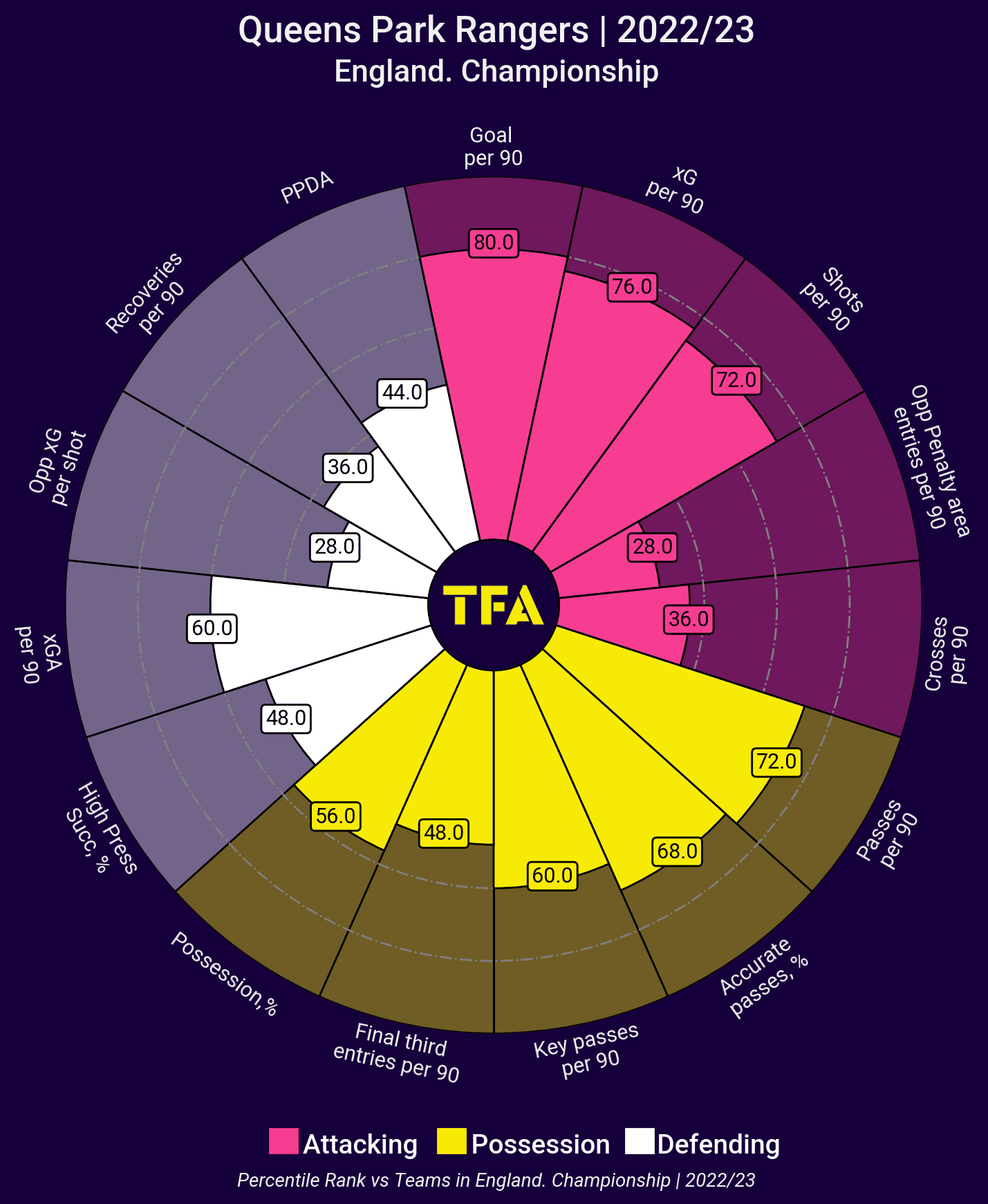
Attacking data
QPR rank extremely high for goals per 90, showcasing how their attacking fluidity helps them to score plenty of goals. This is something that Beale has worked on and he wants his team to be attack-minded. Only two teams have scored more goals this season in the Championship than QPR with 25.
Furthermore, their high volume of shots per 90 encourages and enhances the goalscoring ability of the team. Not only this but QPR are able to create chances which enable them to get shots off. One way in which QPR don’t attack very prominently is with crosses into the box. Their ranking for crosses per 90 places them relatively low.
Possession data
With his side in possession, Beale likes his men to be comfortable in possession and able to receive the ball in numerous different areas on the pitch. The high percentile ranking for passes per 90 and accurate passes per 90 emphasises how well they move the ball. In comparison, their possession ranking is lower than both passing areas. This means that QPR are passing the ball quicker and more frequently than other teams in the league.
But they are not just passing for passing’s sake. QPR are well-placed for progressive passes. Their 60th percentile rank for key passes per 90 shows how they move the ball forwards to create shooting chances.
Defensive data
Defensively, QPR are solid with only five teams in the league conceding fewer goals than them. Their data tells a lot about how they like to defend without the ball. Their just-below-average rank for PPDA shows that they are not overly aggressive without the ball but are more conservative and calculated. Furthermore, a low ranking for recoveries per 90 shows that they don’t go pressing and sit back and soak up pressure before picking off an opposition pass.
In possession
Beale mostly sets his side up in a 4-3-3 formation but has also deployed a 4-3-1-2. Both formations have similarities and differ slightly in the final third. When QPR have the ball, they are open, expansive and willing to take risks. The way they look to build up involves the forward players stretching the pitch and making it as big and open as possible. Due to the forward players pushing so far forwards, it leaves a massive amount of space in the central area in which the midfield players can play.
The image below shows how the midfield player drops very deep into the defensive line which in turn allows the centre-backs to split extremely wide and play in the space that the fullback would. Allowing the midfield player to receive the ball deep like this will often give him more time on the ball.
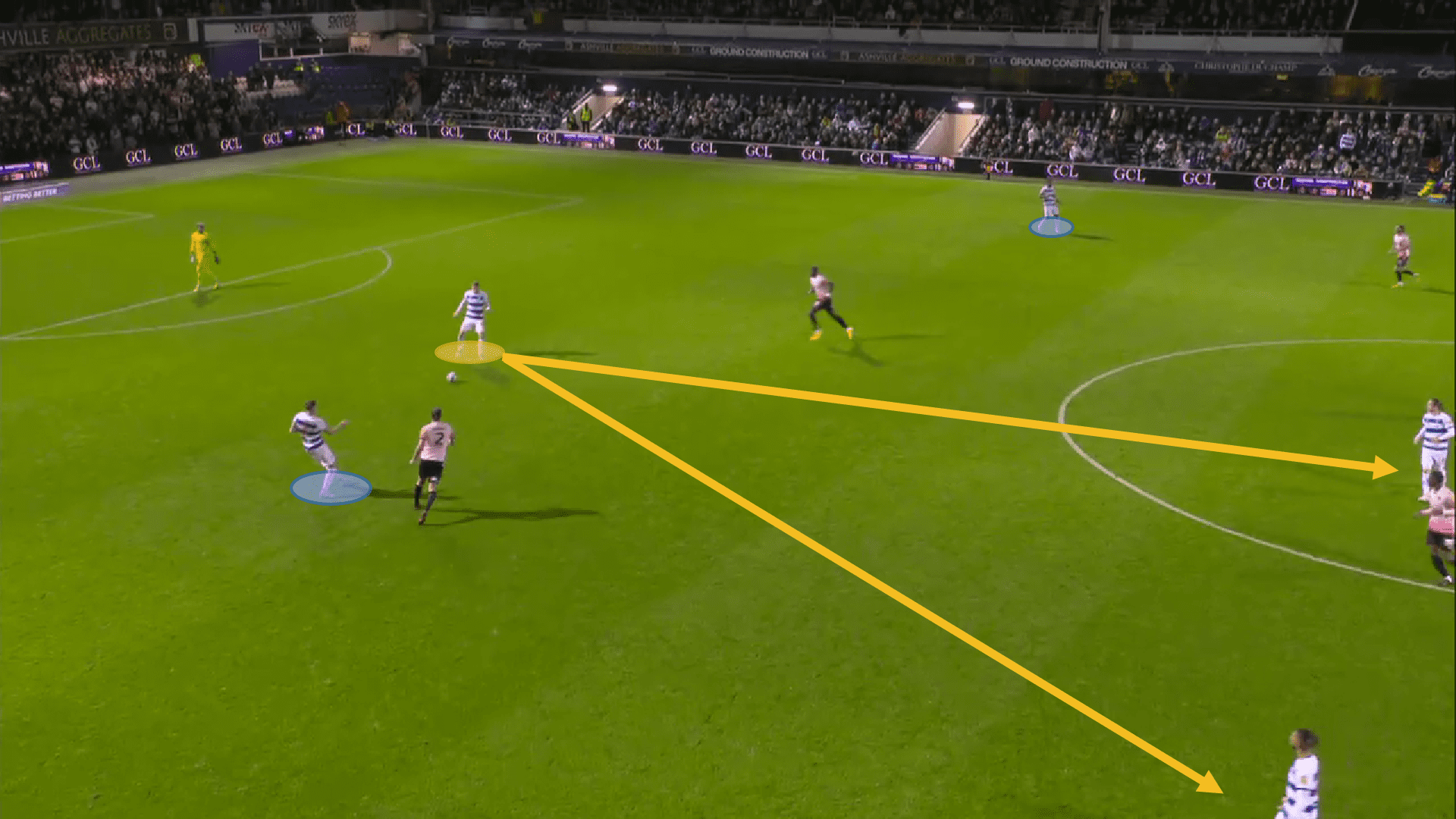
With more time on the ball, the midfielder can look to play progressively forwards into the midfield. This is where the other two of the three midfield players come into practice. They need to actively look to receive the ball from the deep man. If this works then QPR can comfortably beat any press and build up quickly into the attacking third of the pitch.
Once the forward players have advanced up the pitch, it allows the fullbacks in the back four to push higher up the field. The image below shows the set-up that the defensive and midfield players take up whilst building up play. The back four is very stretched and wide, creating space for each individual player. This space allows the player to comfortably enjoy possession of the ball whilst having a teammate in space.
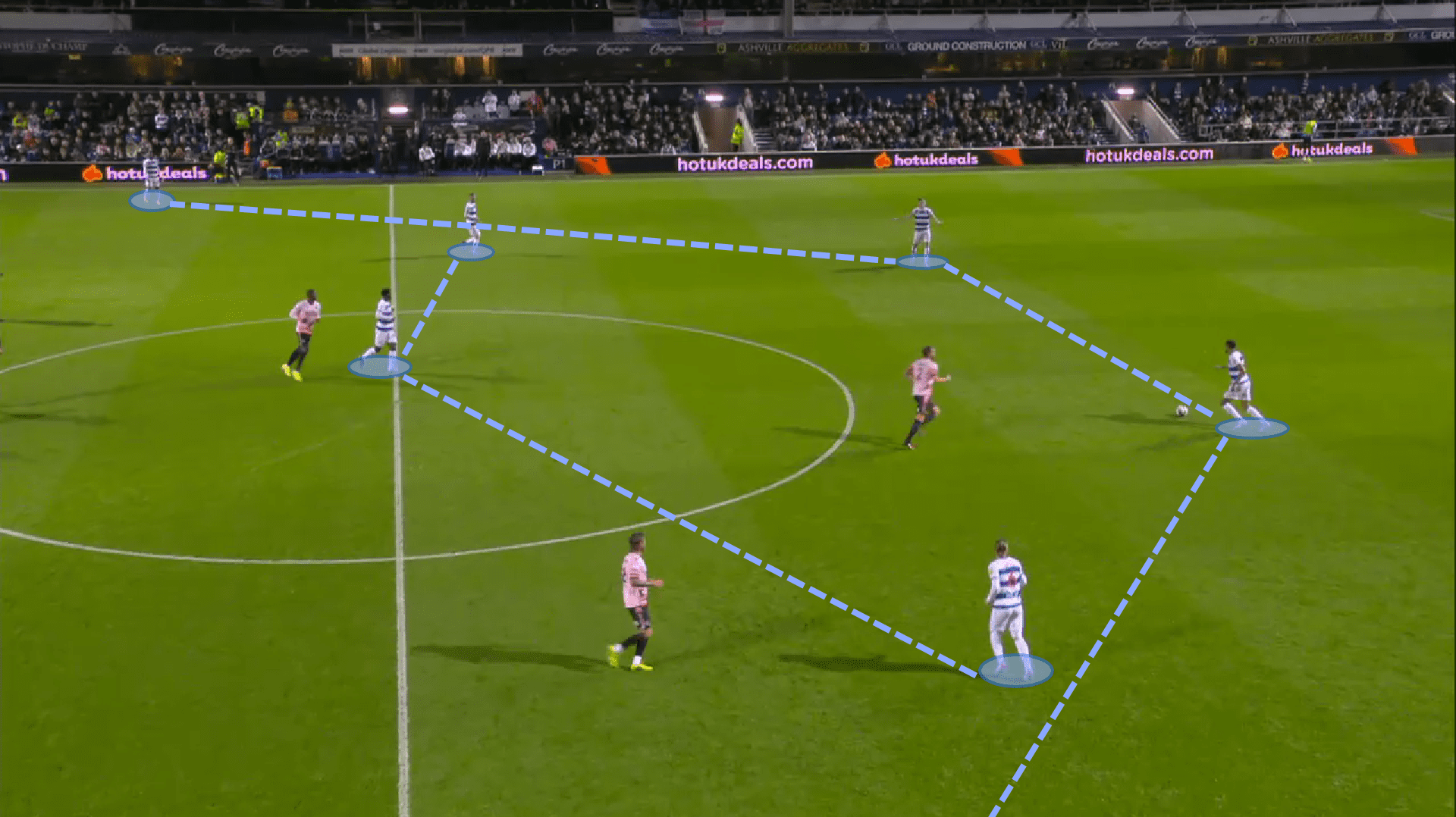
The midfield is set up in a way that occupies the wide space vacated by the advancing fullbacks. To do this, the outside midfield players of the three pulls wide and drops deeper into this space. This then opens up the central area for a ‘pivot’ player to enter and receive the ball. The set-up implemented by Beale maximises the space in the middle third of the pitch, allowing for his team to comfortably have multiple options for who can receive the ball.
Once play has progressed into the final third, QPR are very direct and penetrative in the way they look to attack the penalty area. Their quick combinations in the wide channels lead to isolation in the half-space. This creates immediate and threatening chances for their attacking players to exploit.
With the ball in possession of a fullback, a wide player looks to make an inverted run into the half-space. Once possession has found its way to the attacking players they look to drive directly into the penalty area.
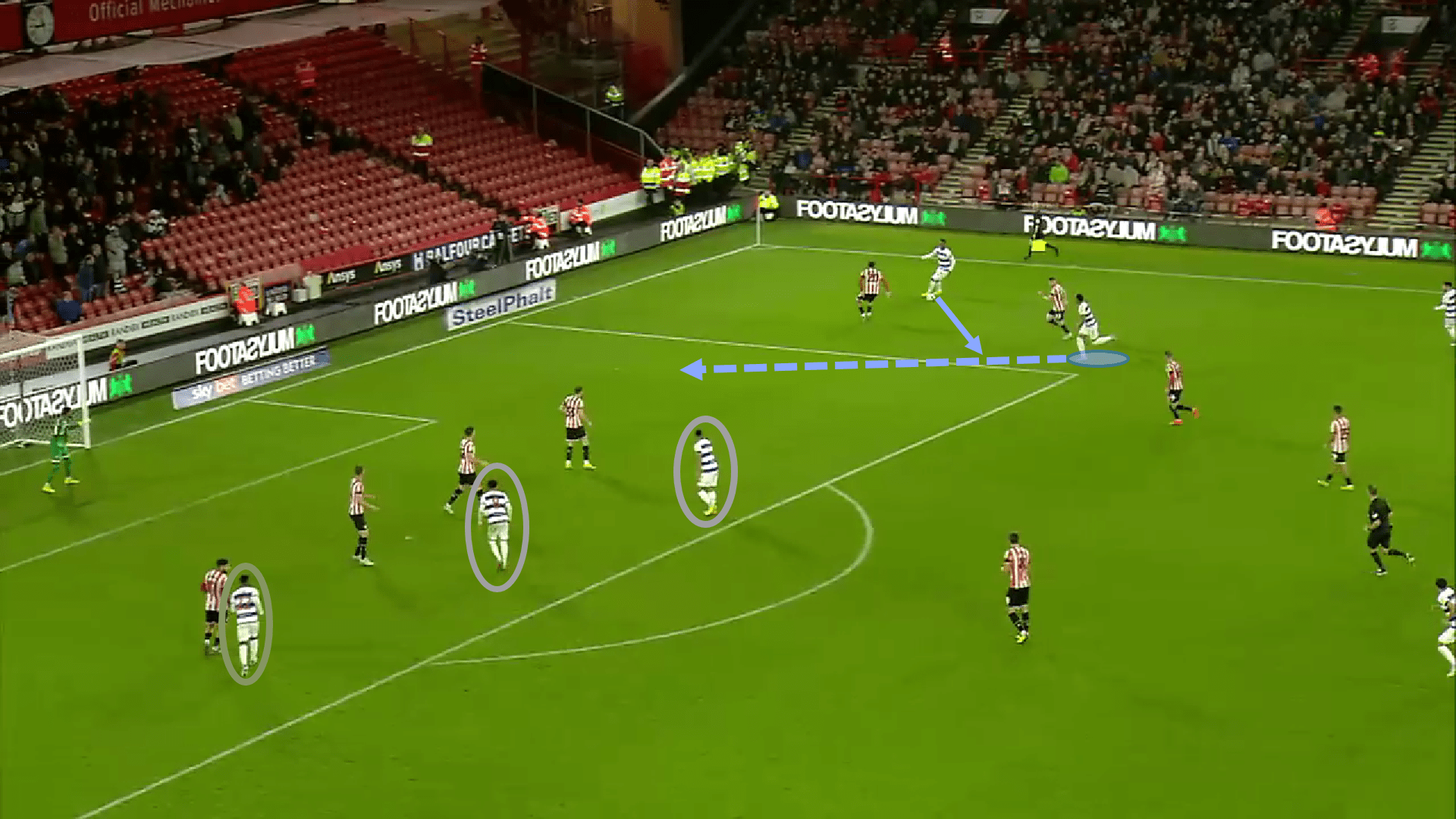
The image above shows how this setup works in real-time. The advancing player takes the ball into the box where he has three options to pass the ball to. With a four versus three situation, the chances of a first contact drastically increase. QPR’s overload in the box does see them score a lot of first-time finishes inside the penalty area. The man looking to cross the ball has a choice of a low-drilled cross, a lifted cross or even a cutback. All attacking players ensure that all of these options are always viable, making QPR a real threat in the final third.
One main threat in QPR’s attack is talisman Ilias Chair. Chair prefers to play as a ’10’ which is suited to Beale’s 4-3-1-2 formation but is also comfortable playing on the wing. His attacking and dribbling ability is exceptional and key to QPR’s success. The Moroccan star has 3 goals and 6 assists already this season and is attracting a lot of Premier League interest. Below are his penetrating carries in the EFL Championship 2022/23 season.
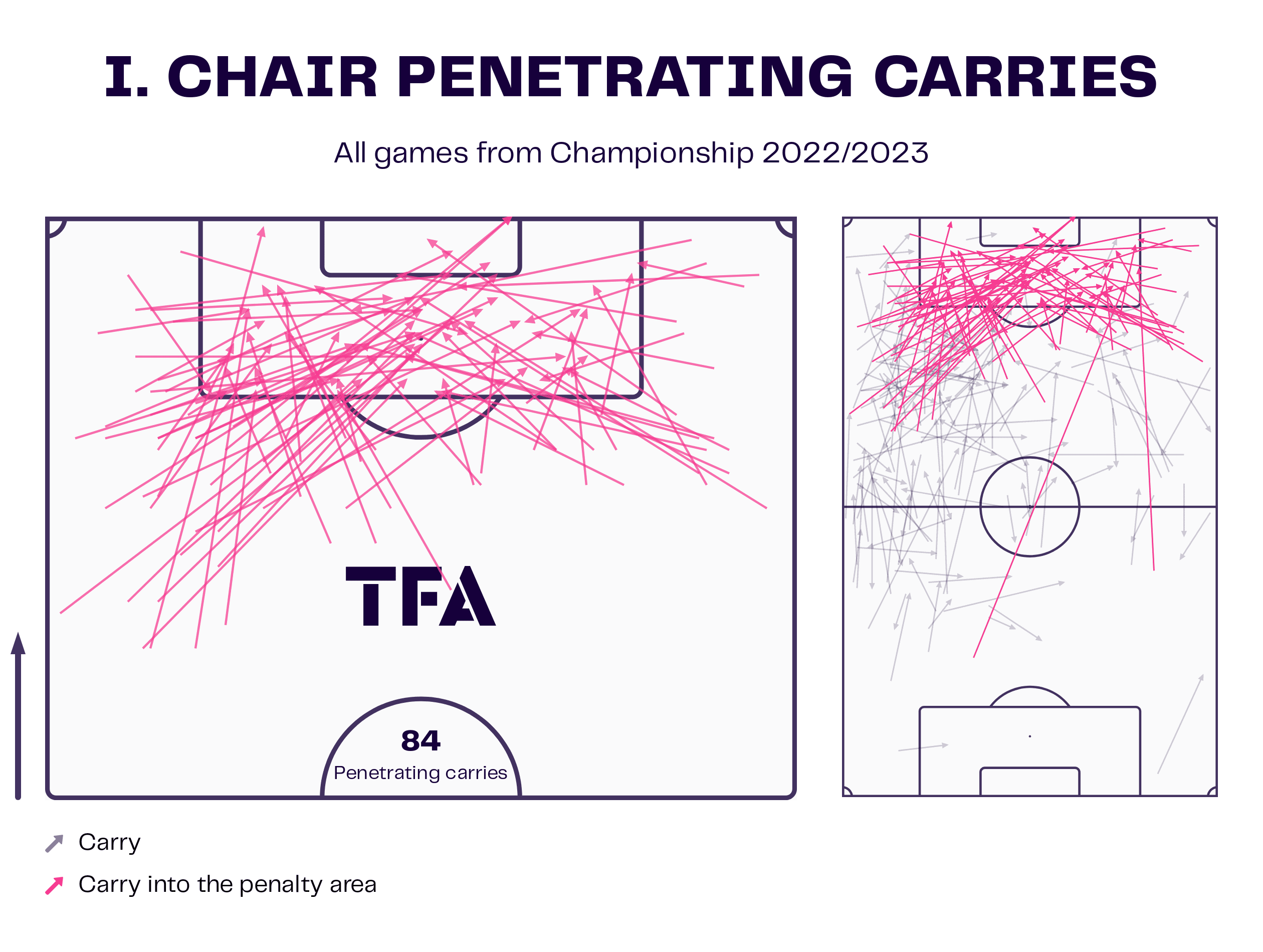
Out of possession
Without the ball, Beale wants his side to be tough but also diverse and able to implement different styles. When defending from the front, QPR can be quite aggressive and pragmatic in their approach. The below example shows how they engage in a form of a press with the opposition defence. By doing this they almost go man for man in a small area high up the pitch. The reasoning behind this is that if they regain possession the chance of scoring is higher.

The attacking three, have all congregated close to the ball and have essentially cut off all passing lanes. By doing this they increase the chances of a turnover either through a long ball or an interception. As the image above shows, there is a large amount of space left unmarked on the pitch and if the opposition are able to play around this press, then QPR will be exploited.
Looking to defend from the front, the forward players have a situation-dependent role. For example, the striker is often asked to closely mark the ‘6’ of the opposition. By doing this Beale wants to limit the opposition’s build-up as effectively as possible. In the example below the striker is asked to apply pressure on the midfield player from Sheffield United.
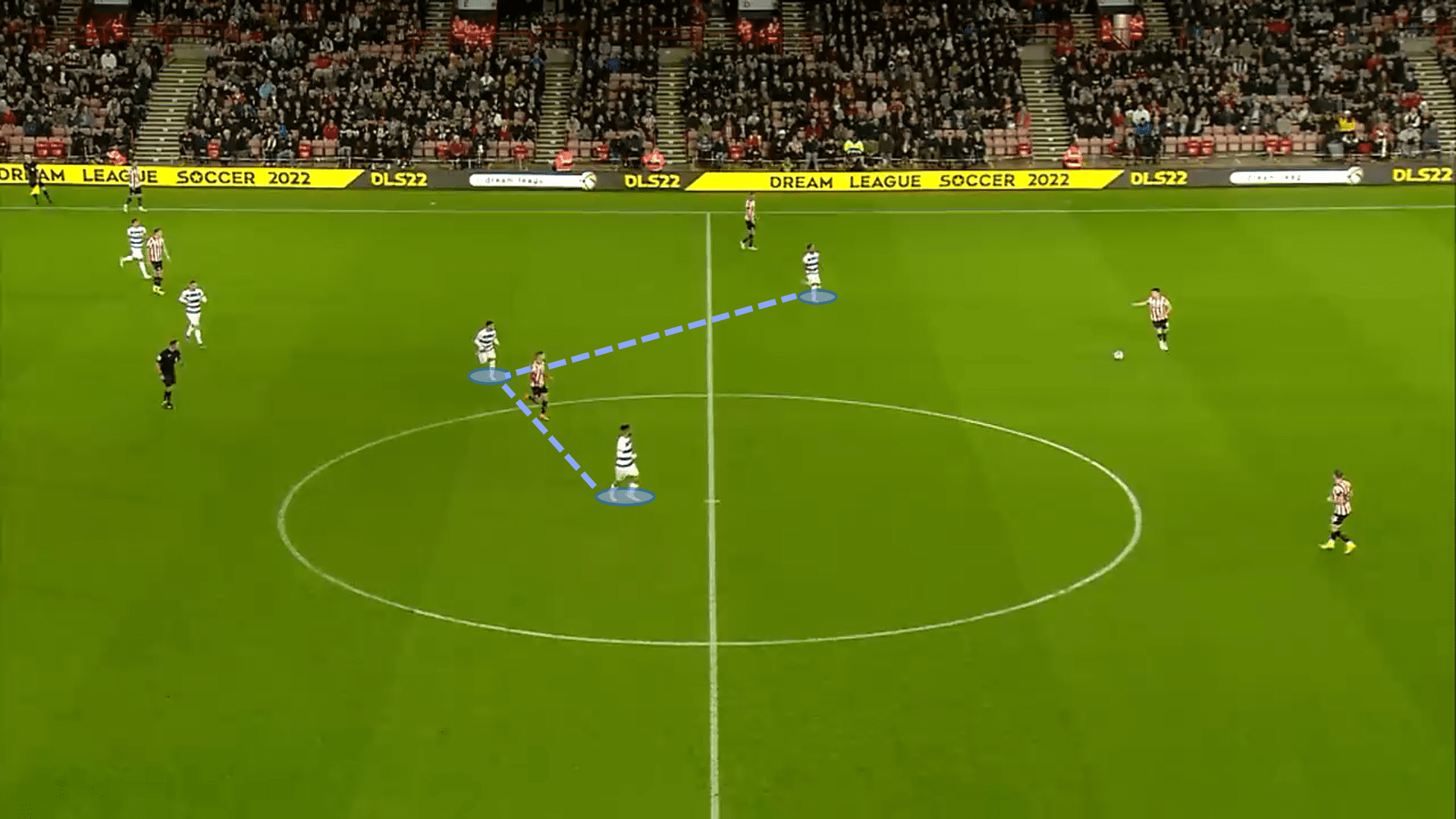
Once, QPR have settled into their defensive shape of 4-3-3, they look to make it difficult for their opponents to play through. They set their low block up and don’t expect to be broken down. The 4-3-3 shape gives them a lot of cover in wide areas as the wingers are often asked to drop deep to help defend.
The space between the defence and midfield is something that should be noted. Beale has instructed his players to make the gap as small as possible. By doing this it stops any opposition players from having time to turn and play ‘in between the lines’. This area between defence and midfield is an area of high priority for Beale as if there is a player who receives the ball in this space, they are quickly closed down.
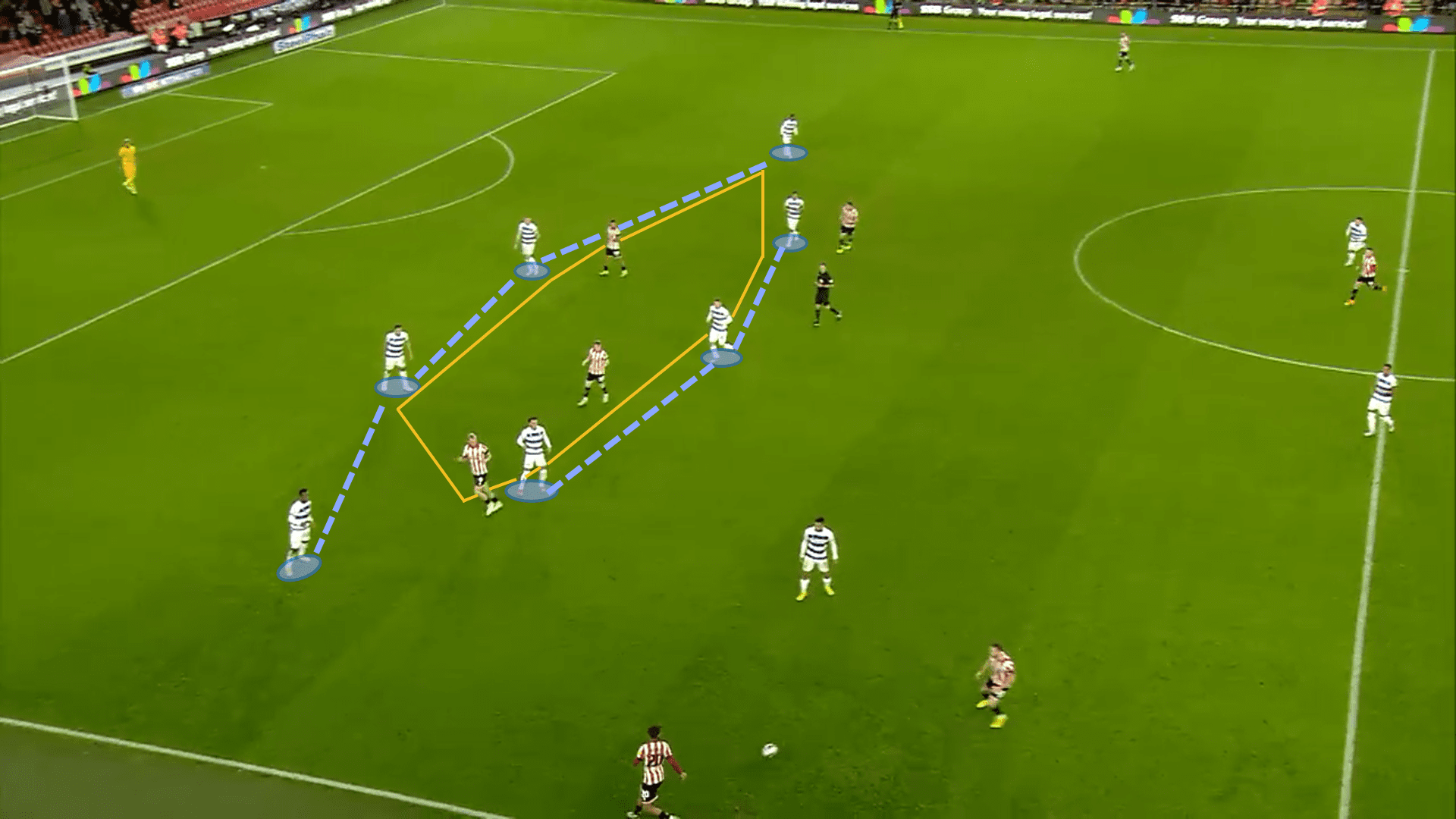
This defensive solidity and diversity allow for QPR to defend against all styles of play and opposition. They can comfortably sit back and absorb pressure as well as being well equipped to press higher up the pitch.
Attacking transition
Once the R’s have regained possession, they are quick to break forward. Like their attacking style of player, they look to break into the attacking third with direct dribbling and quick progressive runs. The image below shows how QPR assert their possession and immediately have two runners in behind.
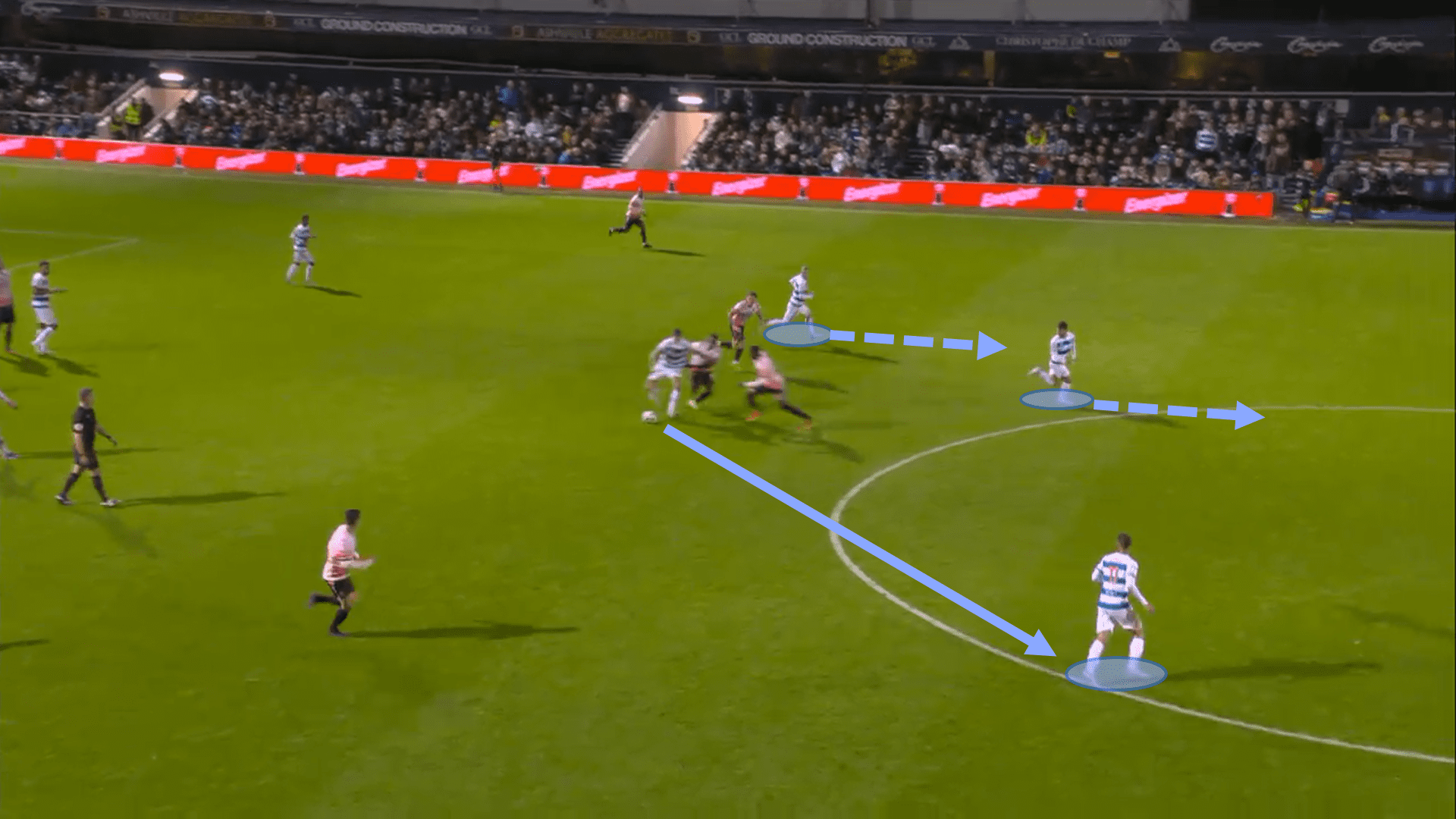
Defensive transition
Upon defensive transition, QPR are very quick to regain some form of defensive shape. They look to provide cover for teammates who may potentially be out of position. By doing this, it ensures that the chances of an opposition counterattack that results in a goal are limited. As well as this, they have some light pressure applied to the ball which will delay their opponent’s attacking momentum. Furthermore, they don’t commit to making a tackle in a 1 versus 1 situation and wait for a teammate to come and support them before they commit.
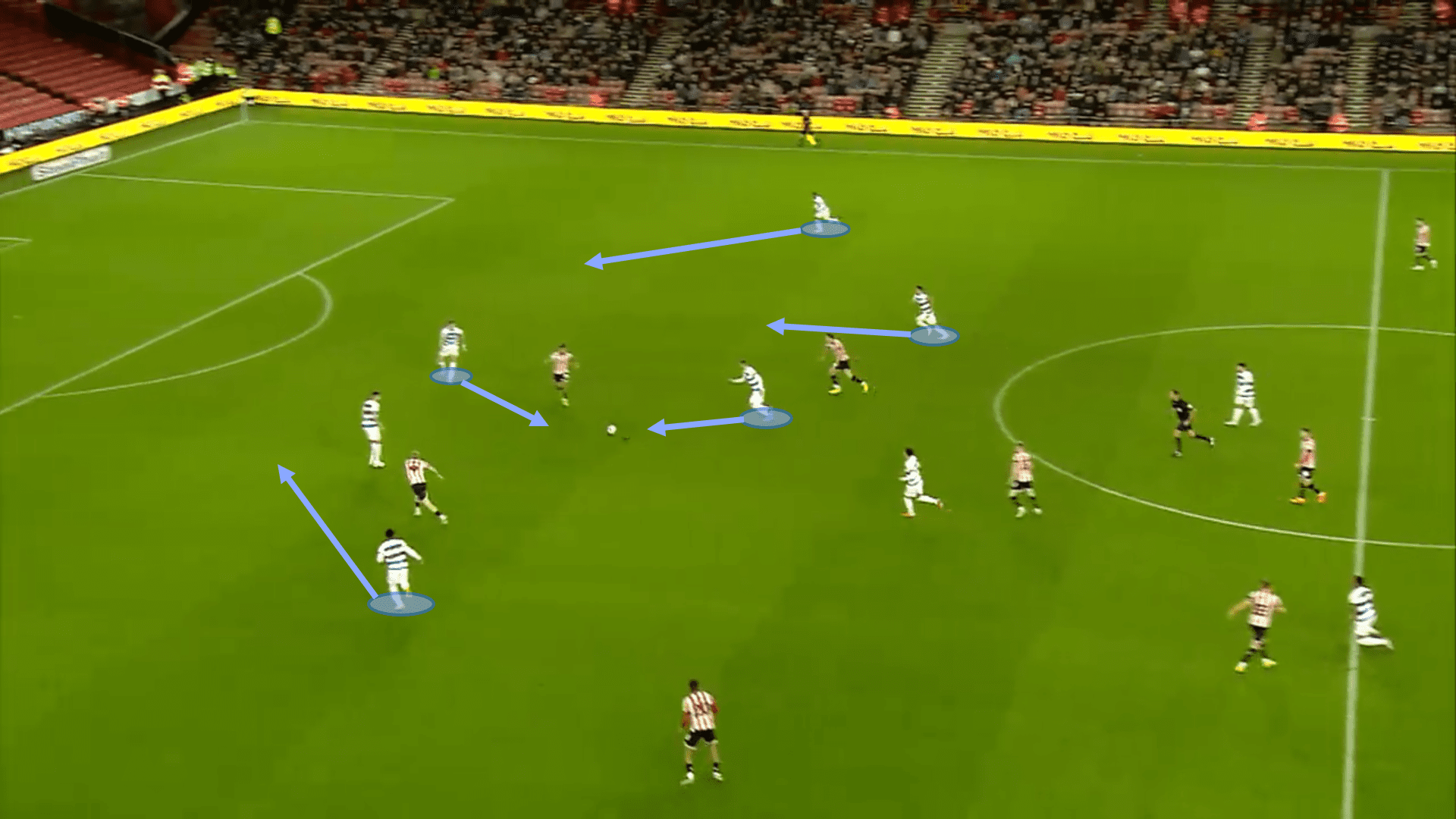
Conclusion
Overall, Michael Beale is an exceptional manager who has a great understanding of the modern game. His strategies and philosophy align with the squad he has inherited. His success this season has not gone under the radar and it is only a matter of time before he is managing in the top flight of English football, either with QPR or elsewhere.





Comments